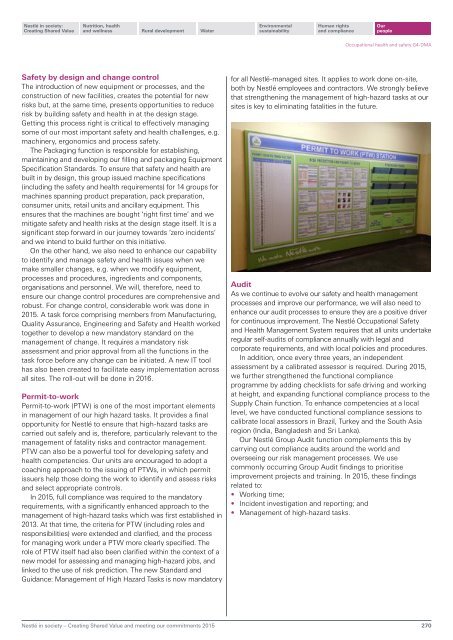Nestlé in society Creating Shared Value and meeting our commitments 2015
nestle-csv-full-report-2015-en
nestle-csv-full-report-2015-en
Create successful ePaper yourself
Turn your PDF publications into a flip-book with our unique Google optimized e-Paper software.
<strong>Nestlé</strong> <strong>in</strong> <strong>society</strong>:<br />
Creat<strong>in</strong>g <strong>Shared</strong> <strong>Value</strong><br />
Nutrition, health<br />
<strong>and</strong> wellness<br />
Rural development<br />
Water<br />
Environmental<br />
susta<strong>in</strong>ability<br />
Human rights<br />
<strong>and</strong> compliance<br />
Our<br />
people<br />
Occupational health <strong>and</strong> safety G4-DMA<br />
Safety by design <strong>and</strong> change control<br />
The <strong>in</strong>troduction of new equipment or processes, <strong>and</strong> the<br />
construction of new facilities, creates the potential for new<br />
risks but, at the same time, presents opportunities to reduce<br />
risk by build<strong>in</strong>g safety <strong>and</strong> health <strong>in</strong> at the design stage.<br />
Gett<strong>in</strong>g this process right is critical to effectively manag<strong>in</strong>g<br />
some of <strong>our</strong> most important safety <strong>and</strong> health challenges, e.g.<br />
mach<strong>in</strong>ery, ergonomics <strong>and</strong> process safety.<br />
The Packag<strong>in</strong>g function is responsible for establish<strong>in</strong>g,<br />
ma<strong>in</strong>ta<strong>in</strong><strong>in</strong>g <strong>and</strong> develop<strong>in</strong>g <strong>our</strong> fill<strong>in</strong>g <strong>and</strong> packag<strong>in</strong>g Equipment<br />
Specification St<strong>and</strong>ards. To ensure that safety <strong>and</strong> health are<br />
built <strong>in</strong> by design, this group issued mach<strong>in</strong>e specifications<br />
(<strong>in</strong>clud<strong>in</strong>g the safety <strong>and</strong> health requirements) for 14 groups for<br />
mach<strong>in</strong>es spann<strong>in</strong>g product preparation, pack preparation,<br />
consumer units, retail units <strong>and</strong> ancillary equipment. This<br />
ensures that the mach<strong>in</strong>es are bought ‘right first time’ <strong>and</strong> we<br />
mitigate safety <strong>and</strong> health risks at the design stage itself. It is a<br />
significant step forward <strong>in</strong> <strong>our</strong> j<strong>our</strong>ney towards ‘zero <strong>in</strong>cidents’<br />
<strong>and</strong> we <strong>in</strong>tend to build further on this <strong>in</strong>itiative.<br />
On the other h<strong>and</strong>, we also need to enhance <strong>our</strong> capability<br />
to identify <strong>and</strong> manage safety <strong>and</strong> health issues when we<br />
make smaller changes, e.g. when we modify equipment,<br />
processes <strong>and</strong> procedures, <strong>in</strong>gredients <strong>and</strong> components,<br />
organisations <strong>and</strong> personnel. We will, therefore, need to<br />
ensure <strong>our</strong> change control procedures are comprehensive <strong>and</strong><br />
robust. For change control, considerable work was done <strong>in</strong><br />
<strong>2015</strong>. A task force compris<strong>in</strong>g members from Manufactur<strong>in</strong>g,<br />
Quality Assurance, Eng<strong>in</strong>eer<strong>in</strong>g <strong>and</strong> Safety <strong>and</strong> Health worked<br />
together to develop a new m<strong>and</strong>atory st<strong>and</strong>ard on the<br />
management of change. It requires a m<strong>and</strong>atory risk<br />
assessment <strong>and</strong> prior approval from all the functions <strong>in</strong> the<br />
task force before any change can be <strong>in</strong>itiated. A new IT tool<br />
has also been created to facilitate easy implementation across<br />
all sites. The roll-out will be done <strong>in</strong> 2016.<br />
Permit-to-work<br />
Permit-to-work (PTW) is one of the most important elements<br />
<strong>in</strong> management of <strong>our</strong> high hazard tasks. It provides a f<strong>in</strong>al<br />
opportunity for <strong>Nestlé</strong> to ensure that high-hazard tasks are<br />
carried out safely <strong>and</strong> is, therefore, particularly relevant to the<br />
management of fatality risks <strong>and</strong> contractor management.<br />
PTW can also be a powerful tool for develop<strong>in</strong>g safety <strong>and</strong><br />
health competencies. Our units are enc<strong>our</strong>aged to adopt a<br />
coach<strong>in</strong>g approach to the issu<strong>in</strong>g of PTWs, <strong>in</strong> which permit<br />
issuers help those do<strong>in</strong>g the work to identify <strong>and</strong> assess risks<br />
<strong>and</strong> select appropriate controls.<br />
In <strong>2015</strong>, full compliance was required to the m<strong>and</strong>atory<br />
requirements, with a significantly enhanced approach to the<br />
management of high-hazard tasks which was first established <strong>in</strong><br />
2013. At that time, the criteria for PTW (<strong>in</strong>clud<strong>in</strong>g roles <strong>and</strong><br />
responsibilities) were extended <strong>and</strong> clarified, <strong>and</strong> the process<br />
for manag<strong>in</strong>g work under a PTW more clearly specified. The<br />
role of PTW itself had also been clarified with<strong>in</strong> the context of a<br />
new model for assess<strong>in</strong>g <strong>and</strong> manag<strong>in</strong>g high-hazard jobs, <strong>and</strong><br />
l<strong>in</strong>ked to the use of risk prediction. The new St<strong>and</strong>ard <strong>and</strong><br />
Guidance: Management of High Hazard Tasks is now m<strong>and</strong>atory<br />
for all <strong>Nestlé</strong>-managed sites. It applies to work done on-site,<br />
both by <strong>Nestlé</strong> employees <strong>and</strong> contractors. We strongly believe<br />
that strengthen<strong>in</strong>g the management of high-hazard tasks at <strong>our</strong><br />
sites is key to elim<strong>in</strong>at<strong>in</strong>g fatalities <strong>in</strong> the future.<br />
Audit<br />
As we cont<strong>in</strong>ue to evolve <strong>our</strong> safety <strong>and</strong> health management<br />
processes <strong>and</strong> improve <strong>our</strong> performance, we will also need to<br />
enhance <strong>our</strong> audit processes to ensure they are a positive driver<br />
for cont<strong>in</strong>uous improvement. The <strong>Nestlé</strong> Occupational Safety<br />
<strong>and</strong> Health Management System requires that all units undertake<br />
regular self-audits of compliance annually with legal <strong>and</strong><br />
corporate requirements, <strong>and</strong> with local policies <strong>and</strong> procedures.<br />
In addition, once every three years, an <strong>in</strong>dependent<br />
assessment by a calibrated assessor is required. Dur<strong>in</strong>g <strong>2015</strong>,<br />
we further strengthened the functional compliance<br />
programme by add<strong>in</strong>g checklists for safe driv<strong>in</strong>g <strong>and</strong> work<strong>in</strong>g<br />
at height, <strong>and</strong> exp<strong>and</strong><strong>in</strong>g functional compliance process to the<br />
Supply Cha<strong>in</strong> function. To enhance competencies at a local<br />
level, we have conducted functional compliance sessions to<br />
calibrate local assessors <strong>in</strong> Brazil, Turkey <strong>and</strong> the South Asia<br />
region (India, Bangladesh <strong>and</strong> Sri Lanka).<br />
Our <strong>Nestlé</strong> Group Audit function complements this by<br />
carry<strong>in</strong>g out compliance audits around the world <strong>and</strong><br />
oversee<strong>in</strong>g <strong>our</strong> risk management processes. We use<br />
commonly occurr<strong>in</strong>g Group Audit f<strong>in</strong>d<strong>in</strong>gs to prioritise<br />
improvement projects <strong>and</strong> tra<strong>in</strong><strong>in</strong>g. In <strong>2015</strong>, these f<strong>in</strong>d<strong>in</strong>gs<br />
related to:<br />
• Work<strong>in</strong>g time;<br />
• Incident <strong>in</strong>vestigation <strong>and</strong> report<strong>in</strong>g; <strong>and</strong><br />
• Management of high-hazard tasks.<br />
<strong>Nestlé</strong> <strong>in</strong> <strong>society</strong> – Creat<strong>in</strong>g <strong>Shared</strong> <strong>Value</strong> <strong>and</strong> meet<strong>in</strong>g <strong>our</strong> <strong>commitments</strong> <strong>2015</strong> 270


